#sega System 32
Explore tagged Tumblr posts
Text

#spiderman the videogame#sega#arcade#spiderman#Beat 'em up#1991#System 32#sega System 32#Roppyaku Tsurumi#Kazuhiko Nagai#Las Vegas Amusement Expo#arcade marquee#marquee
14 notes
·
View notes
Text
youtube
🎮 Arabian Fight (Arcade)
Complete Gameplay: https://youtu.be/oICOiyiXj6A
#ArabianFight #Arcade #Sega #BeatEmUp #StreetsOfRage #FinalFight #GoldenAxe #Medieval #Arabian #アラビアンファイト #SegaSystem32 #AstroCityMini #SegaAM2 #princess #Viciogame #Gameplay #Walkthrough #Playthrough #Longplay #LetsPlay #Game #Videogames #Games
#Arabian Fight#Arcade#Sega#Beat Em Up#Streets Of Rage#Final Fight#Golden Axe#Medieval#Arabian#アラビアンファイト#Sega System 32#Astro City Mini#Sega AM2#princess#Viciogame#Gameplay#Walkthrough#Playthrough#Longplay#Let's Play#Game#Videogames#Games#Youtube
1 note
·
View note
Text
That Game Which Sonic First Appeared In
No, I'm not talking about the first Sonic The Hedgehog video game for the Sega Genesis. I'm talking about that one game where he appeared as an air freshener inside the cockpit of a race car! Yeah, that game! So, apparently there was another version of this game that was demonstrated at AOU Show 1991 and was also being location-tested at an arcade in Shibuya.
A YouTube member who goes by the name 'Lyle (Hiroshi) Saxon' uploaded a video of their walkabout from Harajuku to Shibuya in Tokyo in 1991, who also happened to come across this game. I've clipped the moment this game appears in the video. Enjoy~
#crosspost#sertimus.xyz#video games#sega#rad mobile#1991#arcade#sega system 32#appreciation#youtube#embed#video
2 notes
·
View notes
Text
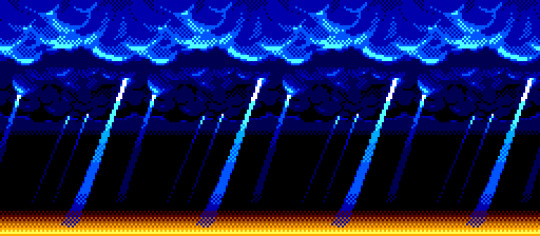

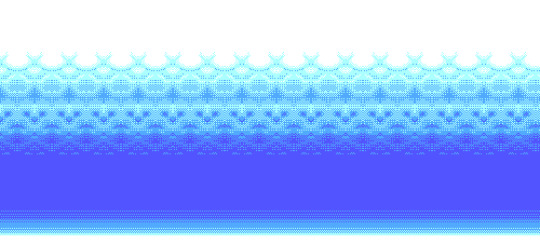
Chuck Rock 2: Son of Chuck (1993) (Amiga, CD32, Game Gear, Master System, Mega-CD, Mega Drive)
#chuck rock 2#chuck rock#amiga#CD 32#game gear#sega master system#master system#sega#mega cd#commodore amiga#amiga games#sega games#retrogaming#pixel art
40 notes
·
View notes
Text
The "Wait no, the PS3 isn't retro" List
Have you ever said "The Wii isn't old, that came out when I was in High School"? Do you remember getting an N64 for Christmas? Did you play Halo 3 on Xbox Live with your friends while complaining about your math class? Then get ready to be destroyed by the ages of your childhood game systems (As of 2023)! Just remember that an age of 15 years makes it retro.
Famicom/NES: 1983(JP)/1985(US) Age: 40/38
Mega Drive/Genesis: 1988(JP)/1989(US) Age: 35/34
Super Famicom/SNES: 1990(JP)/1991(US) Age: 33/32
Sega Saturn: 1994(JP)/1995(US) Age: 29/28
PlayStation: 1994(JP)/1995(US) Age: 29/28
Nintendo 64: 1996 Age: 27
Sega Dreamcast: 1998(JP)/1999(US) Age: 25/24
PlayStation 2: 2000 Age: 23
GameCube: 2001 Age: 22
Xbox: 2001(US)/2002(JP,EU) Age: 22/21
Xbox 360: 2005 Age: 18
PlayStation 3: 2006 Age: 17
Nintendo Wii: 2006 Age: 17
Nintendo Wii U: 2012 Age: 11
PlayStation 4: 2013 Age: 10
Xbox One: 2013 Age: 10
221 notes
·
View notes
Text
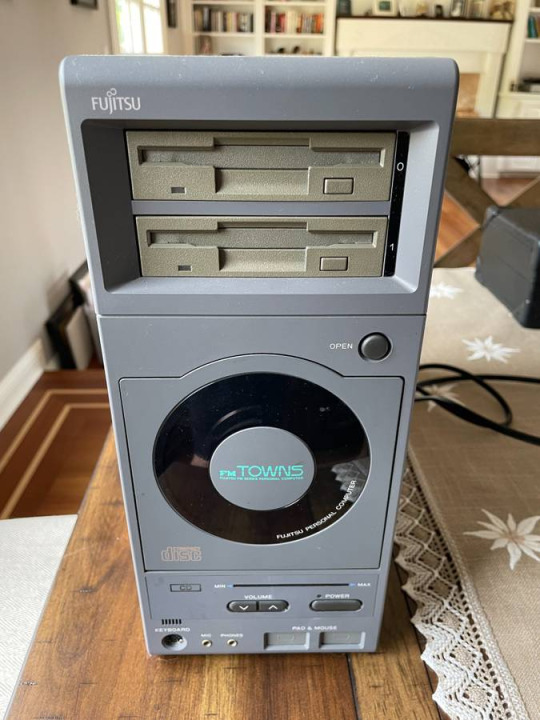
Fucking Gorgeous FM-Towns model 2F on craigslist near me. I don't have money or the knowledge to use this thing, but god it's amazing.

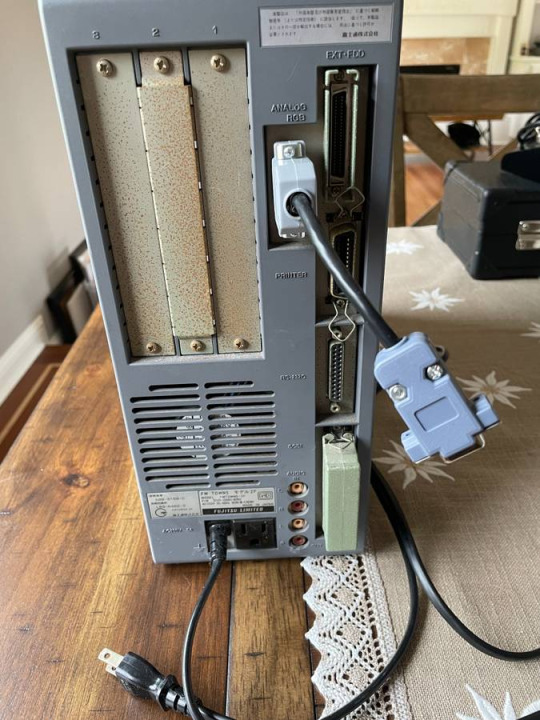
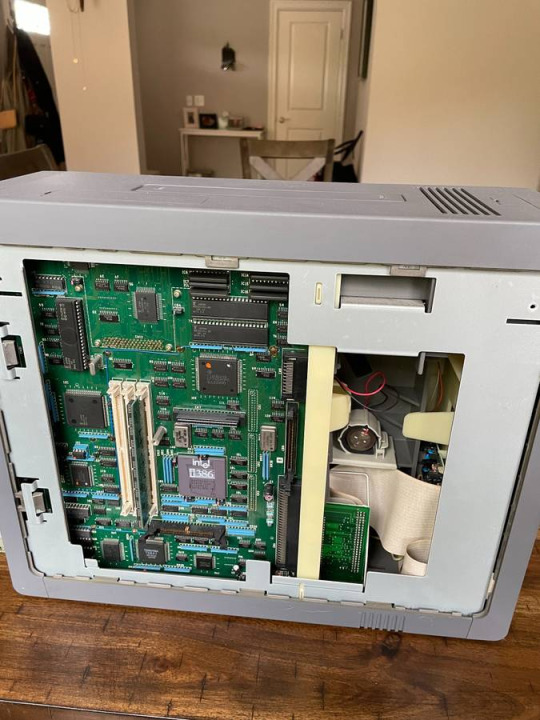
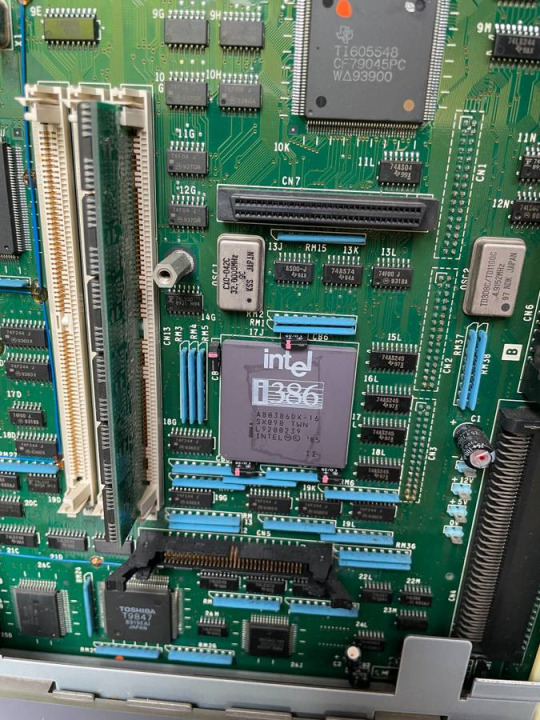
The FM Towns was a Fujitsu computer introduced in 1989 in Japan. It's built around an Intel 386, but it's not a fully PC compatible system. It ran Windows 3.x and Towns OS, which was built on top of MS-DOS and ran in 32-bit mode using an extender.
It didn't require a hard drive, booting the OS off the CD-ROM drive. It uses a custom graphics chip that's not VGA compatible, supporting sprites and overlays, with full kanji in ROM.
Audio-wise, it used a Yamaha OPN2, so it sounds much like a Sega Megadrive/Genesis.
Later systems added DOS/V (a version of MS-DOS designed for Japanese users) support, making it more like a MS-DOS computer.
There was also the FM Towns Marty, which made it into more of a console, looking less like a PC. This kept compatibility, however.

(This is, by the way, the only console to ship with a floppy drive standard)
Anyway these machines are neat and rare, but part of why they're rare is that they didn't sell very well. They're full computers so they're pretty expensive, and the FM Towns series was getting beaten by NEC's PC98 at first and then DOS/V clones later. They just didn't have the compatibility with DOS/V software to really justify them being a viable choice over the much cheaper DOS/V clones, and they had a smaller library than the much more popular PC98 series.
Still, they're very nifty machines.
Fun fact: They're called "FM Towns", right? FM is Fujitsu Micro, but "Towns" is the codename. They were named after the physicist Charles H. Townes, who did some of the fundamental work in the development of the maser, a predecessor to the laser, for which he shared a Nobel Prize in 1964.
You'll note his name is "Townes", but the system is "Towns". Futjitsu changed the spelling so that people would pronounce it correctly, rather than potentially pronounce it "tow-nes".
271 notes
·
View notes
Text
Sonic 30th Anniversary Symphony (2021) - My reaction 3 years later
youtube
I am going to admit one thing. I am a Sonic fan, and it has always been this way since 2006 when I got my hands on Sonic Advance 3 for my Game Boy Advance SP. At the time I was one year away from starting elementary school and my family was not well off at the time, so I had to make do with what I could play. Little did I know that my first encounter with the blue hedgehog would change my life forever as I know it today.
Then as I grew older I was able to get some extra games for the systems I did own, such as my childhood 32 bit console, the Sega Saturn. I got Sonic Jam which was my first gateway drug to the classic 16-bit Sonic games, and I even got to roam around in the Sonic World for a bit, doing tasks like collecting rings and such. The Sonic series has its ups and downs, sure, but there is one thing that the Sonic series never fails on, and it became even more apparent when I saw this comment on one particular live-stream where a music teacher was gob-smacked by how fuckin' awesome the Sonic Adventure 2 soundtrack was!

Anyway, this little long-winded intro out of the way, though it still rings true as the picture says. Let's get right into it. As a 30th anniversary birthday present to Sega's premier franchise Sonic the Hedgehog in 2021, Sega decided "Why not make it bigger and better?" They got some Czech Republic philharmonic orchestra to do the orchestrated medleys for many a Sonic game under the sun, all of which remain one of my favorites. Keep in mind, this Symphony came out before Sonic Frontiers and Superstars. Also, I am not the best in terms of being a music critic unlike the Anthony Fantano types so my reviews of them are going to be relatively brief.
Part 1: Countdown
The music playing during the first 15 minutes of countdown is nothing short of spectacular. The track list is as follows:
A New Journey - Sonic Unleashed
Comfort Zone (Main Menu) - Sonic Mania/Plus
It Doesn't Matter (Instrumental) - Sonic Adventure 2
Sonic Goes U.G. Mix - Sonic Gems Collection
Fist Bump (Piano Version - Theater Room) - Sonic Forces
Mission (theme of Sonic 3D Blast) - Sonic Generations
Tropical Resort (Area Theme) - Sonic Colours
Part 2: The Orchestra
The Philarmonic Orchestra masterfully conducted a beautiful rearrangement of almost every Sonic game's soundtrack out there. I say "almost every" because for the Orchestra portion it's missing Sonic CD, the GBA and DS Sonic games and Sonic Boom. But that's minor substitutions in favor of something a lot grander, and I appreciate it. I mean, they even represented games like Sonic Drift 2 and Tails Adventures! Even NiGHTS got a shoutout. How about that for cool?
Part 3: Tomoya Ohtani
Tomoya Ohtani Band. Oh man, what can I say? Well, they played three songs, so let's get right to it.
Reach for the Stars (Re-Colors)
The Re-Colors version of Reach for the Stars as found in Sonic Colours Ultimate, the remaster of the Nintendo Wii game now available on PS4/5, XBOX, Switch and PC. This song absolutely rocked the socks off when I first played the original game on the Wii, and this arrangement is even better still.
Speak with Your Heart (Original + Rainbow Mix)
Things go normal for the first few minutes of this song, which I like, and then Tomoya Ohtani drops a bombshell when it turns into the "Rainbow Mix" which has a trap beat type vibe to it. I love it!
Endless Possibility from Sonic Unleashed (vocals: Nathan Sharp)
Nathan Sharp is the guy who sings covers of Sonic songs under the best name you could ever give, "NateWantsToBattle" under his record label "Give Heart Records". Endless Possibility is a song that people have loved for years and years and years. It's a song which was originally performed by the same people that did the vocal intro for Phineas and Ferb. Nathan Sharp swoops in and delivers the BEST version of the song yet!
Part 4: Crush 40 (Jun Senoue & Johnny Gioeli)
Crush 40 is also a staple among Sonic fans. From hit songs like Open Your Heart, Live and Learn, Sonic Heroes, I Am... All of Me, and so on, their music has touched lives everywhere around the world. Fun fact, they used to be known as Sons of Angels for a short period of time, where some of their Sons of Angels-era songs were used in the Sega arcade game NASCAR Arcade. The songs in NASCAR Arcade would be released in the only music album to bear the Sons of Angels artist name, "Thrill of the Feel". Speaking of which, they sang six songs before adding two more after fans (this was in 2021 and we were still in lockdown so....) "demanded" more from them. Fun fact: Jun Senoue also did some songs for the Game no Kanzume "Sega Games Can" discs for the Sega Mega CD. Johnny Gioeli also provided vocals for another band under his wing called Hardline. The six initial songs are as follows, which all really will rock your sound system off.
Open Your Heart (Sonic Adventure)
Sonic Heroes
Green Light Ride (Team Sonic Racing)
Sonic Boom (Sonic CD USA edition) (Crush 40 VS Cash Cash version)
I Am... All of Me (Shadow the Hedgehog)
Knight of the Wind (Sonic and the Black Knight)
Part 5: The Grand Finale Songs
Whooo~!!! Here comes the big ones. Two legendary songs all from one game. All before ending it off with an orchestrated mix of "Friends" by Hyper Potions.
These two songs are all from one of the best Sonic games of all time, Sonic Adventure 2.
Escape from the City (vocals: Nathan Sharp)
No one in their right mind would want to tell you that this song from after Sonic jumps off the helicopter in a bid to escape GUN forces is not legendary.
Yet here is Escape from the City, one of the BEST Sonic songs. And, of course, another spotlight by the King of Sonic song covers, Nathan Sharp. The Philarmonic Orchestra also added to the grand vibe of the song by making it even better still.
Live and Learn
There's nothing I can say. One of the GOAT (Greatest of All Time) Sonic songs just got a whole lot better.
7 notes
·
View notes
Text
Hell is terms like ASIC, FPGA, and PPU
I haven't been doing any public updates on this for a bit, but I am still working on this bizarre rabbit hole quest of designing my own (probably) 16-bit game console. The controller is maybe done now, on a design level. Like I have parts for everything sourced and a layout for the internal PCB. I don't have a fully tested working prototype yet because I am in the middle of a huge financial crisis and don't have the cash laying around to send out to have boards printed and start rapidly iterating design on the 3D printed bits (housing the scroll wheel is going to be a little tricky). I should really spend my creative energy focusing on software development for a nice little demo ROM (or like, short term projects to earn money I desperately need) but my brain's kinda stuck in circuitry gear so I'm thinking more about what's going into the actual console itself. This may get techie.
So... in the broadest sense, and I think I've mentioned this before, I want to make this a 16-bit system (which is a term with a pretty murky definition), maybe 32-bit? And since I'm going to all this trouble I want to give my project here a little something extra the consoles from that era didn't have. And at the same time, I'd like to be able to act as a bridge for the sort of weirdos who are currently actively making new games for those systems to start working on this, on a level of "if you would do this on this console with this code, here's how you would do it on mine." This makes for a hell of a lot of research on my end, but trust me, it gets worse!
So let's talk about the main strengths of the 2D game consoles everyone knows and loves. Oh and just now while looking for some visual aids maybe I stumbled across this site, which is actually great as a sort of mid-level overview of all this stuff. Short version though-
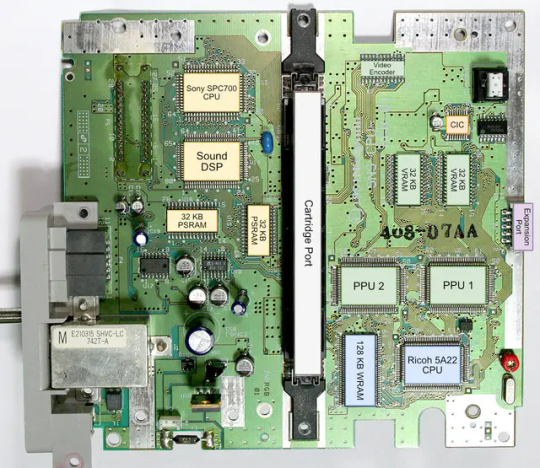
The SNES (or Super Famicom) does what it does by way of a combination of really going all in on direct memory access, and particularly having a dedicated setup for doing so between scanlines, coupled with a bunch of dedicated graphical modes specialized for different use cases, and you know, that you can switch between partway through drawing a screen. And of course the feature everyone knows and loves where you can have one polygon and do all sorts of fun things with it.
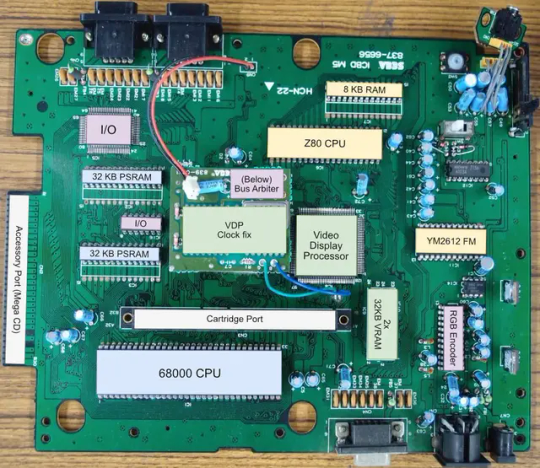
The Genesis (or Megadrive) has an actual proper 16-bit processor instead of this weird upgraded 6502 like the SNES had for a scrapped backwards compatibility plan. It also had this frankly wacky design where they just kinda took the guts out of a Sega Master System and had them off to the side as a segregated system whose only real job is managing the sound chip, one of those good good Yamaha synths with that real distinct sound... oh and they also actually did have a backwards compatibility deal that just kinda used the audio side to emulate an SMS, basically.
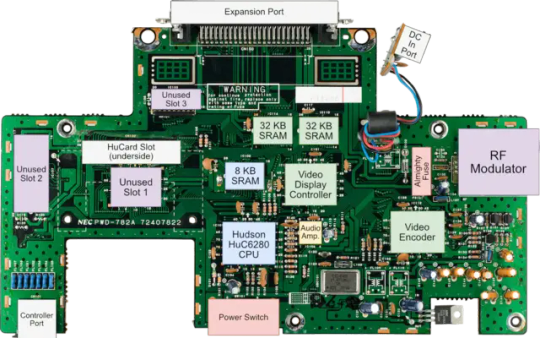
The TurboGrafix-16 (or PC Engine) really just kinda went all-in on making its own custom CPU from scratch which...we'll get to that, and otherwise uh... it had some interesting stuff going on sound wise? I feel like the main thing it had going was getting in on CDs early but I'm not messing with optical drives and they're no longer a really great storage option anyway.
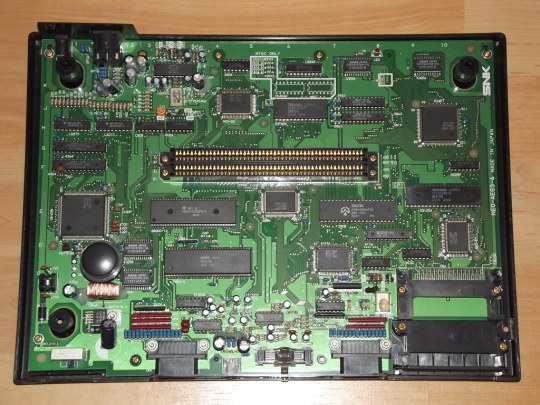
Then there's the Neo Geo... where what's going on under the good is just kind of A LOT. I don't have the same handy analysis ready to go on this one, but my understanding is it didn't really go in for a lot of nice streamlining tricks and just kinda powered through. Like it has no separation of background layers and sprites. It's just all sprites. Shove those raw numbers.
So what's the best of all worlds option here? I'd like to go with one of them nice speedy Motorolla processors. The 68000 the Genesis used is no longer manufactured though. The closest still-in-production equivalent would be the 68SEC000 family. Seems like they go for about $15 a pop, have a full 32-bit bus, low voltage, some support clock speeds like... three times what the Genesis did. It's overkill, but should remove any concerns I have about having a way higher resolution than the systems I'm jumping off from. I can also easily throw in some beefy RAM chips where I need.
I was also planning to just directly replicate the Genesis sound setup, weird as it is, but hit the slight hiccup that the Z80 was JUST discontinued, like a month or two ago. Pretty sure someone already has a clone of it, might use that.
Here's where everything comes to a screeching halt though. While the makers of all these systems were making contracts for custom processors to add a couple extra features in that I should be able to work around by just using newer descendant chips that have that built in, there really just is no off the shelf PPU that I'm aware of. EVERYONE back in the day had some custom ASIC (application-specific integrated circuit) chip made to assemble every frame of video before throwing it at the TV. Especially the SNES, with all its modes changing the logic there and the HDMA getting all up in those mode 7 effects. Which are again, something I definitely want to replicate here.
So one option here is... I design and order my own ASIC chips. I can probably just fit the entire system in one even? This however comes with two big problems. It's pricy. Real pricy. Don't think it's really practical if I'm not ordering in bulk and this is a project I assume has a really niche audience. Also, I mean, if I'm custom ordering a chip, I can't really rationalize having stuff I could cram in there for free sitting outside as separate costly chips, and hell, if it's all gonna be in one package I'm no longer making this an educational electronics kit/console, so I may as well just emulate the whole thing on like a raspberry pi for a tenth of the cost or something.
The other option is... I commit to even more work, and find a way to reverse engineer all the functionality I want out with some big array of custom ROMs and placeholder RAM and just kinda have my own multi-chip homebrew co-processors? Still PROBABLY cheaper than the ASIC solution and I guess not really making more research work for myself. It's just going to make for a bigger/more crowded motherboard or something.
Oh and I'm now looking at a 5V processor and making controllers compatible with a 10V system so I need to double check that all the components in those don't really care that much and maybe adjust things.
And then there's also FPGAs (field programmable gate arrays). Even more expensive than an ASIC, but the advantage is it's sort of a chip emulator and you can reflash it with something else. So if you're specifically in the MiSTer scene, I just host a file somewhere and you make the one you already have pretend to be this system. So... good news for those people but I still need to actually build something here.
So... yeah that's where all this stands right now. I admit I'm in way way over my head, but I should get somewhere eventually?
11 notes
·
View notes
Text
Happy Late Birthday To The Sega 32x
This is a copy of the script, the full video is out. So make sure to check it out to see extra stuff like commercials from the time, gameplay, more context specific jokes and stuff. You can watch the full video here: https://www.youtube.com/watch?v=Rtf9nP65noc

Howdy Earthlings, the fourth of December was the Japanese release date of one of gaming’s weirdest oddities, it’s real birthdate was the 21st of November as this addon came out in the US first. But the Sega 32x was an addon designed for the Sega Genesis (or Mega Drive for European audiences). This add on was designed to help the 16 bit genesis bridge the gap between it and 32 bit before their release of the Sega Saturn their dedicated 32 bit system. Shrimply, they knew the Saturn was coming soon and wanted Americans to experience 32 bit early to hold them over until they could get the Saturn. This is a really baffling decision because literally the day after the 32x was release they released the Saturn in japan. So why would someone buy it if they knew the Saturn wouldn’t be far off? It’s like Sega was asking consumers to buy hardware they’d throw out in a year. But it wasn’t even a year, just 6 months later the Saturn would be out. Not to mention they even tried to release the 32x in Japan and Europe after the Saturn’s release.

The Sega Saturn was an amazing system that had it's life cut short because of the 32x release. People didn't view the Saturn as an upgrade.
The reason Sega did this was likely in their long standing war with Nintendo. They were always trying to out do Nintendo by getting technology to the market first. Sega was always faster than Nintendo to ring in the next generation then wave it around in their face. Then Nintendo would come in a year or two later and do it better than Sega with better game releases. Sega had the hardware but Nintendo had the fans. The Genesis beat the Snes to 16 bit and got to brag about their system that had double the bits and more power than the NES. Their game gear was also full color and 8 bit which was better than Nintendo’s Gameboy. Besides, the game gear was terrible and rushed. The Genesis was great, but the Snes was around the corner and Nintendo had the games.

This is the Sega Genesis the system that the 32x slotted into. It was a 16 bit console just like the SNES and beat it to market by 2 years. Cheaper too.
There was one other good reason they release the 32x despite the Saturn being on the horizon. See, the 32x was going to use the same chip as the Saturn meaning developers could play with and practice development on similar hardware before they got the Saturn. Not a bad idea if the system was developed a year prior and had the time it needed to cook.
Now it was Sega’s time to get on to 32 bit before Nintendo could and rather than wait for the Saturn they rushed out the 32x. I’m going to avoid giving you the full history of everything Sega. But they released an add on before this called the Sega Cd and it could play FMV, you’ve probably heard of Night Trap, this was the Night Trap machine. Well each of these add ons had their own power source and brick and it was a bit of problem having all of these hooked up.

The Sega Cd was an attempt by Sega to squeeze some more power out of the Genesis. It played disc based games and CDs and could play video. Most of the games featured real actors more than it did graphically impressive cutscenes.
But what could it do? Well the 32x could play all of your original genesis games and it’s massive 40 game library of 32 bit games. I’ve said bit a thousand times, honestly it’s impossible to avoid when talking about Sega they emblazoned bits on all their hardware and it was their main marketing strategy for their systems.

Talking about Sega home consoles without talking about bits would be like talking about peanut butter and jelly without mentioning bread. Sega wanted you to know they had more bits and they didn’t care if you knew what a bit was. All you needed to know was more was better and that having more meant better games. It doesn’t even matter if their games were good or not, just that they had more bits. So what the hell is a bit? Well back in the day when games couldn’t display every color under the sun consoles would brag about how many colors they could display in the form of bits. More bits meant more colors. But it also meant what kind of processing they had. A 32 bit processor meant more power in every way. So as an example, 8 bit to 16 bit doesn’t sound like much of a leap but compare two games and it’s a pretty massive difference. That genesis was out before the SNEs and looked this good was huge. Now here is 16 bit versus 32 bit. It’s not a massive upgrade visually but you can see things like shading more clearly. But the 32x could also do 3d and had better sound.

Source: Retromantra YouTube
But Sega didn’t seem to get that advanced technology adopted too early can be worse than the previous generation of tech and clearly people weren’t impressed as this add on nearly killed Sega, in reality is was a bunch of back to back failures. The game gear was bad, the 32x was bad, the Saturn underperformed and the Dreamcast didn’t get any new titles for it’s first year. That many failures back to back can really destroy consumer trust. If bits mattered more, well Atari Jaguar had them both beat and is anyone talking about the jaguar?

Atari Jaguar claimed to be 64 bit but in reality it had two 32 bit processors. Tech nerds will also say that it was technically 64 bit because it had a 64 bit datapath.
This failure left us with just 40 titles for the 32x and like the game gear before it, it was mostly ports of previous systems. Being the tech of the future doesn’t matter if all it does it play last gen’s games. But this was not only a bad idea for the current gen but it also discouraged people from buying the next gen. “I already invested almost 600 dollars on my genesis with the Sega CD and 32x, why would I upgrade to the Saturn?” As well as the inverse of “Why get a 32x plus the other 400 bucks of equipment when I can wait for the Saturn. Just a year later and the N64 came out. It was 64 bits, 3d, and half the price of the Saturn and a third of the 32x plus genesis and CD.
So what amazing games did the 32x get before it was dropped a year later? Don’t worry, I won’t be talking about all forty. Just the exclusives.

The Amazing Spider Man: Web Of Fire is the last game released for the system. Unfortunately for Web of Fire it released after Sega had already announced that they’ll no longer be supporting the 32x. Those who did play it said it was an ugly flat game that looked worse than 16 bit. Gameplayers also said that it was the millionth thing wrong with the game industry. Despite that, it sells for 650 dollar used proving that rare games don’t mean good games.

Cosmic Carnage, some of the best fighters on the system were ports from other consoles or where later ported elsewhere. Cosmic Carnage is a 32x exclusive that lived and died on the system. Despite the 32x having a broadened color palette Cosmic carnage opted for the darkest, drabbest, and ugliest color palette. Although the spritework itself is good. The story is about a space prison ship that recently had a mutiny where their captors were killed and the life support dwindling. They hail a military ship and then ram into it. Only 4 passengers from the military ship and the prison survived and they have to fight each other to be the one who uses the single remaining escape pod.

There’s a sexy snake lady and a knock off xenomorph so that’s cool. The coolest feature of this game is the equipment though, each military character has 6 pieces of equipment to choose from, a light and heavy form of arm, chest, and leg armor. Heavy allows for heavier hits, and light means being faster but as damage is taken they break off Senran Kagura style changing their performance and even their combos. Stylistically it’s very strange many moves cause attacks to zoom towards the camera and makes me feel like I forgot my 3d glasses. Overall, it’s not the worst thing I’ve played but I won’t be recommending it to anyone.

Darxide, you’ll never see a physical copy of this one as long as you live. This is the most expensive 32x game out there costing more than 1,200 dollars loose. You could buy a new gaming pc for that much. This is also a european exclusive release. It’s a space flight and combat sim that looks ugly, dirty, and crunchier than that sock you keep hidden. But at least it’s 3d, I guess? It runs slow as well being very similar to a powerpoint presentation, so despite being on more advance hardware than starfox 1 and two it looks worse and plays worse. This one is so rare in part because of it’s exclusivity but like web of fire it came in late.

Golf Magazine: 36 Great Holes Starring Fred Couples, wow 36 great holes? I wonder if mine is in there? Golf too, so I’m excited to be stroking it near 36 of the greatest holes, even if it means Fred Couples has to watch. Graphically this one isn’t too bad, the intro has fmv on a cartridge which is kind of nuts and the golfer looks pretty realistic for being made of pixels. The magazine on the menu also looks great the photo being nearly perfect. You can even make a sort of custom golfer using a selection of characters, pants, shirts, and clubs. It tracks your stats and it over all looks like a pretty decent golf game. Lots of modes, and lots of courses. It’s a surprisingly feature rich game. But just by being on the Sega Tumor you’d have an easier time playing literally any other golf game.

Knuckles Chaotix, wouldn’t be a sega system without a sonic game. Sorry folks, this Sega system does not have a Sonic game. Not even a genesis port. All you get is Knuckles. At least Sega thought this one was good enough to get ported to future systems. It’s also a direct sequel to Sonic and Knuckles 3 and features an expanded cast of Knuckles, Vector the Crocodile, Espio the chameleon, Charmy bee, and mighty the armadillo and all with unique ways to get through the map. Knuckles glides and climbs wall, Espio can cling to ceilings and walls, vector can boost and climb walls, Charmy can fly and hover, and mighty can wall jump. Other than that the game plays similarly to sonic. Other than you’re connected to a second character by a leash, rather than entirely slowing you down this leash works like a rubber band allowing you to do some tricks to take advantage of the momentum. But you can still get them stuck on the environment making progress impossible unless you pay the game ten rings to teleport your partner too you. If you want to play something like this without the tether I’d suggest Sonic Heroes. Other than that this is probably the prettiest classic sonic game, bright, beautiful sprite work and super colorful with lots of detail.

Kolibri, do not be fooled by this box art. Whatever it is you were expecting IS NOT IT! You might think, aw cute this looks like a relaxing game about a hummingbird. It’s actually a shmup, your hummingbird FIRES LASERS. The story is kind of bonkers not that you’d ever know it from playing the game because the story is detailed in the manual and not told to you. Deep inside earth there is an ancient magical crystal that empowers the earth with it’s life force. Allowing the earth to give life. The crystal isnt from earth though but crash landed here from the explosion of a nearby planet that was once blooming with life too. Once lodged in the earth’s core the earth began to create life, for millions and millions of years. But for every good energy there must be a bad and evil one.
The crystal’s twin corrupted by the radiation from it’s planet’s explosion, it wandered space continuing to build its dark energies until it was time to crash into earth. Out poured the dark energy corrupting the earth but by this time the wonderful life giving stone was losing it’s power. Until one day a humming bird named kolibri encountered it, with it’s last breath it gave Kolibri their newfound powers, to shoot sick ass lasers! As kolibri you need to cleanse the earth of it’s newfound corrupter by shooting bird lasers. As a bonus the manual also gives us instructions on how to make a hummingbird feeder and tells us all about humming birds. Like did you know hummingbirds need to ear every 15 minutes to stay healthy? Honestly, this game sounds nuts and I don’t want to spoil myself on it.

Metalhead is a game where you play mechs called Metal heads. The game is full 3d, features voiceacting, and plays metal music. So it’s a game called metal head where you play metal heads, which are metal mechs, and the game plays metal music that will please humanoid metalheads. The game also features some very funny character stills that look like really blurry photos as bad pngtubers. The faces are kind of terrifying honestly, this could be marketed as a horror game from how uncanny it is. Graphically it’s very much like darxide, it’s good for the hardware but ugly, muddy, and drab. It’s apparently not a terrible game so maybe the weirdness isn’t a waste.

Motocross Championship is a motocross racing game that’s 2d characters on a 3d stage. It’s genuinely pretty awful to look at, ugly brown environment, ugly graphics, it doesn’t look like much of an improvement over 16 bit racers. It also has the lap, time, speed, and position taking up the entire bottom third of the screen for the entirety of the race. This reduced screen space means turns are constantly sneaking up on you.

RBI Baseball ‘95, I really don’t like sports games so in terms of how it plays I’m the wrong person to ask. But graphically speaking, the game looks absolutely nuts. The sprites are outstanding. But team selection sucks as it’s most raw text menus looking more like a spread sheet. The game has no music, but does have some light voice acting and crowd cheering. Honestly it just looks boring.

Shadow Squadron, is a space flight sim that looks surprisingly similar to starfox. It even runs at a decent frame rate unlike starfox. The graphics aren’t anything impressive, it’s like a darker starfox. It’s just missing interesting characters and story. It’s also pretty short, it’s possible to play this in one sitting.

Tempo, is an action character platformer that is just the cutest thing I’ve ever seen. The game is bright, colorful, and the sprite work is perfect. It even has a banging sound track. The game is just so visually impressive looking like a lost gba game brought to modern hardware. IT also makes good and frequent use of 3d with weird and trippy backgrounds and claymation looking bossfights. I 100% vibe with this aesthetic too, I really don’t like platformers but I’m really wanting to play this one on stream some time. Tempo is an interesting platformer too having a combination of features from other platformers making it a unique experience.
Tempo is a grasshopper and can hover jump, double tap to dash, kick, the kick can be used to wall jump, jump on enemy heads, and a snap attack that stuns enemies. Best of all in my opinion is you get a health bar instead of a one hit death game like many of the platformers before it. If it turns out you like this one there is 2 other tempo games but they were both released for other systems that didn’t do well like Tempo JR for game gear, and Tempo 2 for Saturn. Maybe if we beg hard enough we can get Sega to bring this one back in a collection and see if we can’t revive him.

Zaxxon’s Motherbase 2000 is the 12th and final exclusive on the 32x. ZM is a very odd shmup. It’s normal in the sense that you play a spaceship shooting up all the things that come towards you but where it get’s weird is it’s perspective. Rather than opting for horizontal or vertical scrolling they chose the secret third option, diagonal scrolling. It has neatly designed backgrounds, simple starfox like 3d graphics, and a weird angle that result in a very cramped feeling game. But what is unique about this game is the hijacking system. Your ship can jump onto enemies and hold them hostage while stealing their abilities. They managed to combine kirby and shmups and it’s a very wild thing to see let along play. This jump can of course also be used to avoid enemy attacks. The weird perspective might make for a difficult game for those used to conventional shmups, but it’s not horrible.
That’s it for all of the exclusives on the 32x, everything else was a port. The system had few exclusives and in most cases, anything that was exclusive on it died on it. Is there anything that is a must play? Not really. Tempo looks cool but also hurts my eyes, Zaxxon has a neat gimmick, and Kolibri looks very cute. I’ll probably check those out in more detail, if there is any of these games that you want to know more about let me know and maybe I can make a dedicated video to it. Also consider following, I have an article in the works similar to this on the game gear, featuring my actual game gear.
#gaming#retro#retrocollection#retrocollector#retrogaming#retrocollecting#gamecollecting#gamecollection#sega 32x#32x#saturn#sega#sega genesis#sega saturn#sega megadrive#megadrive#genesis#sega cd#cd#old#birthday
3 notes
·
View notes
Note
As someone who I know is intricately familiar with Genesis music and the FM synth it uses; why is it that many people (including myself) enjoy the Genesis era Sonic music but when Jin Senoue tries to emulate that sound using Genesis synth samples (Sonic Superstars being the most recent example) it just doesn't sound very good? I know it's literally become a running joke in the community that Senoue uses the Genesis synth too much but it's not like Sonic 1 or 2 had bad soundtracks even though they used the same instrumentation, and Senoue is obviously a very talented composer, so I don't really understand why his attempts to emulate the Genesis soundtracks always turn out so mid.
The general theory I subscribe to is that with the soundtracks to Sonic 1, 2, and presumably even Sonic 3, those games were composed by people who were just writing "real" music. They would pick out real world instruments and write for that sound.
If you've never heard it before, for the 20th Anniversary, Sega put out a compilation soundtrack for Sonic 1 and 2, which included the original demo tracks Masato Nakamura wrote for those games.
youtube
Now these are basically just MIDI files, because they didn't need to be anything more than that. But you can tell he was thinking in terms of horn sections, bass guitar, and so on.
Nakamura would submit these MIDI songs on cassette to Sega, and Sega's sound engineers would transcribe those instruments into something that sounded appropriate for the Genesis hardware.
youtube
Now, Jun Senoue did the same thing, to a degree. Jun's first major Sonic soundtrack was Sonic 3D Blast on the Sega Genesis, and Jon Burton (of Traveler's Tales) revealed Jun's own demo cassette. If you listen to Jun's tracks, they're all done on the Honky Tonk/Rhodes piano. There's no attempt to utilize real world instruments or have any kind of sound diversity. [1] [2] [3] [4]
Instead of writing music for a band, he wrote music for an individual playing a keyboard.
Worse still, it has eventually been revealed as of Sonic Origins that Jun Senoue had very little awareness of how to make Genesis sounding music. Again, he only submitted his songs on cassette. He was not responsible for the FM Synthesis conversion, just the raw notes, which were all written on, and for, a keyboard.
(throwing the rest of this ask under a "read more" tag because it embeds a lot more videos and even some images)
So when it came time for Sonic 4, and they had Jun Senoue do the retro style soundtracks for those games, he was probably pretty out of his depth. He was writing for style of music he did not really have a nuanced understanding of.
youtube
So we get this crunchy, grating, disassociated "this is what the Genesis sounded like, right?" sort of sound. The musical equivalent of one of those early 2000's "How to Draw Manga" books: somebody who thinks they know what they're doing, has actual talent in other adjacent areas, but doesn't actually get this particular niche.
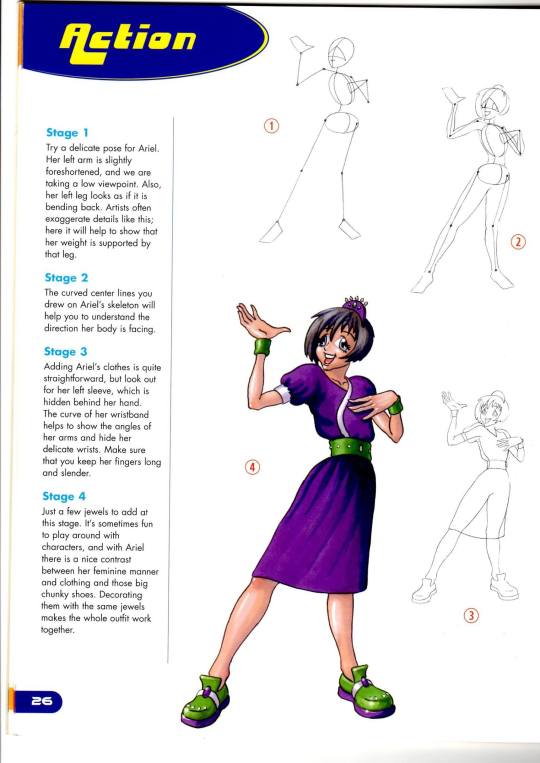
This is one of the reasons why I'm actually a little warmer towards Classic Sonic's music in Sonic Forces -- it's not Jun Senoue. Somebody on that project understood enough and had Naofumi Hataya handle a lot of Classic Sonic's music. He has actual experience with chiptunes and wrote something that feels like it belongs in a Sega System 32 arcade game or something.
youtube
Not every single one of Classic Sonic's songs are stone cold bangers in Forces, but at least they sound more authentically retro than Jun's attempts, because they were written by someone who knew what they were doing.
Beyond that, I don't know why Jun doesn't just, like... do better, in a sense. I suppose I don't know his composing environment and how easy or hard it is to slot in what he'd need to sound more "authentic." I just know from my own perspective how easy it is to grab a VST or a soundfont for common Genesis/Yamaha instruments.
youtube
But even then, more authentic instruments aren't going to solve the problem that this style of music doesn't seem to be his strong suit, even if somebody at Sega keeps pushing him to do it. Thankfully, I think somebody finally realized it, given how Sonic Superstars seemed to be full of his Sonic 4 style fake-retro music and most of it got replaced at the last second.
#questions#biggnife#sonic the hedgehog#sega#sonic team#jun senoue#music#masato nakamura#naofumi hataya#tomoya ohtani#lots of video embeds
17 notes
·
View notes
Text
OutRunners (MD Mini 2)

It's tough to make a sequel to a game that basically gets everything right, but that's the challenge SEGA faced with following up on Out Run. But follow up it did, several times, to varying results. OutRunners was meant to be a return to the relaxing atmosphere of the original game after a couple of installments that went in different directions. In the arcades it ran on SEGA's powerful System 32 hardware, and in the end was the most successful game to use that board. A very fun game, and one that unlike most System 32 games actually received a home console port. Only one, mind you.
Unfortunately, that one home console port was to the Mega Drive. This was a console that had a hard time doing a convincing port of the original Out Run. It never had a hope of handling OutRunners with any sort of fidelity. And indeed, it did not. It forces a splitscreen even in single player, the animation is really choppy, the scaling has too few sizes for each sprite to be convincing, and objects on the road appear at the last second. The collision detection is bizarre, which really hurts the playability of the game.
In its favor, the soundtrack is really good. The new Original Mode might not add to much with its short one-on-one races, but it's something new. It has a two-player mode, and that's always nice. The Japanese version, which is also included in the Mega Drive Mini 2, has a cheat code that lets you play as the car from Virtua Racing. Could this hardware have done a better take on OutRunners? Maybe, but probably not by much. An attempt was made, it was not the worst racing game you could buy for the console, and it's a neat thing to have on the mini-console. I think it's deeply unfortunate that SEGA has never reissued the arcade game on more capable hardware, but that's hardly this port's fault.
5 notes
·
View notes
Text

it’s been roughly just under thirty years at this point, but whenever i see screenshots or gameplay of either ‘donkey kong country’ for the super nintendo or ‘vectorman’ for the sega genesis, i’m still blown away. granted the graphics were pre-rendered, but they looked so good they genuinely looked as good as some early 32-bit games on systems like the 3do and atari jaguar. the lighting effects on ‘vectorman’ in particular? i didn’t even know that the genesis could pull that off.
kudos to both rare and bluesky for pulling off these games.
3 notes
·
View notes
Text
Midnight Gaming: Long Live Eggbug
So last night I played Atari 50th anniversary collection, checked socials later to find.... cohost will shut down by the end of the year... aww..
So Atari is a company thats been around for a long while in the gaming industry, all the way back in the 70's with pong and asteroids, leading to the atari 2600 or vcs as it was called and finally leading to thier last console, the atari jaguar which flopped hard. It was a console that was advertised as a true 64 bit console even though it was really just 2 custom 32 bit processors, making it difficult to make games that run well, in the same decade that has the playstation and the nintendo 64. Yeah, "do the math".
Never really got to experience much of Atari when they were a contender in the scene, heck I wasn't even a year old when the Jaguar was launched so it wasn't really a part of gaming that I had a hands on experience with but I have heard of them. In my general interest in all things gaming in my youth, Atari was brought up sometimes in some gaming mags and online media, AVGN is probably for many people how they heard about Atari as he covered some games on the 2600, even did an episode on the failed 5200 and the Jaguar consoles.

So Digital Eclipse (not to be confused with digital extremes, the warframe folks) has done a 50th anniversary collection that has various games from atari's history, including some unreleased games. Naturally since these games can be easily emulated, a collection of old games wouldnt mean much but theres more to this than just that. You also get a bunch supplemental material such as artwork, behind the scenes documents and videos of interviews with several employees and key figures in atari's history, talking about various things. Cliffy B is there too for some reason.
For me its damn fascinating to follow along a timeline of events, looking at various media and playing some games, getting a feel on Atari's journey over the years. You do learn a few things about the company and how it ran at the time and uhhh.. it certanly looks a bit familiar. Developers having to work overtime, upper management ignoring concerns from thier employees, games being marketed beyond what could actually be delivered leading to consumer backlash, employees losing their jobs in mass. Yeah those problems are still around nowadays huh. 50 years later and nobody has really learnt anything, still making the same mistakes that one time led to the most infamous market crashes in history. Funny thing tho, while the games market did indeed crash in 83, leading to several businesses going bankrupt, for the average 2600 player it was just an odd time in which new 2600 games werent made. Because the 2600 had such a massive install base, eventually new 2600 games got made again, even during the time when the Sega Master System and the Nintendo Entertainment System were leading the console scene. To quote one Garry Kitchen "No one told consumers that there had been a crash. No one went to their house and said "You don't like video games anymore"".
Digital Eclipse also did some other games in the documentary style, the art of karateka and llamasoft. I wouldn't mind checking those out as I feel a documentary that covers a particular subject sounds fascinating to put the lenses of an interactive game, though I suppose it does veer a bit close to "edutainment" territory.
So now with that done, lets move onto the.... news. Cohost is announced to be closing down at the end of year with it converting to a read only format in October. I genuinly enjoyed my time on cohost even if it was short. From looking for alternatives to Tumblr, I stumbled onto it and found a chill sort of site that I felt comfortable browsing, chatting with peeps and sharing posts. It was a site that had an independent vibe that was unique and humble compared to some of its contemporaries. Tumblr weared the mask of being queer friendly despite nuking the odd trans blog every now and then, twitter is a cesspit run by that nepobaby bastard, discord seems to have issues with power tripping mods and creeps. A lot of social media seems to either be.full of techbro crypto ai weirdos or algorithmic data-harvesting software or both! But cohost had the vision of a place that didnt had user-unfriendly practices, instead of just making a site that demands engagement from the user for the sake of profit, the team made the site comfortable to browse and post on, letting people build up communities to hang out and chill in. Sadly that ambition wasnt sustainable due to the issues with both work and finance and in the end, it'll all be shut down.
I'll still be posting Midnight Gaming on Cohost until October as well as on tumblr until I find another site to host this series. Maybe I'll try that dreamwidth place I heard about, maybe i'll actually make a neocities site. We'll see what the future holds.

Until then, Rest in Piece Cohost. Hug your local eggbug today.... oh yeah james earl jones passed away too... awful lot of death lately, an old friend on my fathers side recently lost thier wife too. September what the hell you doing?
Hey whatever happened to those prizes that were won during the Swordquest contest?
Thats all for today, see you tomorrow. Feel free to leave any game suggestions or feedbacks. Anons are currently on.
3 notes
·
View notes
Text

SegaSonic the Hedgehog
セガソニック・ザ・ヘッジホッグ
Sega System 32 (1993)
9 notes
·
View notes
Text
Towards the end of last year, Sega announced that it would be delving into its enviable archives to revive some of its older arcade,16 and 32-bit titles. Fans could scarcely believe it; Shinobi, Streets of Rage, Golden Axe, Crazy Taxi and Jet Set Radio will all see new releases over the next few years or so.
During the rather short montage, a brief glimpse of each game was shown, with some of the titles looking familiar in appearance to previous entries (Crazy Taxi), while others looked to be embarking on a complete departure from what fans are used to stylistically, with Streets of Rage and Golden Axe seemingly going the 3D route.
While there are more questions than answers at this early stage, it was still refreshing to see the genuine excitement and intrigue from Sega fans who, in recent years, have largely been fed scraps when it comes to new iterations of their favourite legacy IPs.
As a childhood Sega fan myself, and while I did find the reveals pleasing, after the initial teaser that dropped earlier that week, I was hoping for some news on two of Sega's older and much-loved classics from the mid-'80s - Out Run and the main subject of this piece, Fantasy Zone.
So, what exactly is the situation with Sega's unique and somewhat niche shmup? Well, after a lengthy hiatus, Opa-Opa's last mainline outing was in what is regarded by fans as the series' best title, Fantasy Zone II DX (also known as Fantasy Zone II: The Tears of Opa-Opa), which was included in the Sega Ages 2500 Series Vol. 33: Fantasy Zone Complete Collection.
youtube
The game's storied development process has been well documented. The original Fantasy Zone II never came to arcades, but was instead exclusive to the Master System home console – and was, therefore, something of a step backwards in purely technical terms (it also made it to arcades, but running on Sega's System E board, which is based on the Master System).
In 2008, Sega worked with M2 to remaster the game, creating an updated version for the System 16 arcade standard, which the original Fantasy Zone ran on. M2's founder and CEO, Naoki Horii, helped fund the project from his own personal budget, claiming that the money he invested was "about the cost of a new car".
Boosted by a RAM upgrade, the System 16B board was given extra horsepower that allowed the development team to introduce complex backdrops, more frames of animation for the game's protagonist and a variety of bosses, each ever so creatively designed, with multiple independent moving parts. M2 dubbed the new board System 16C, due to the aforementioned memory increase to 256 KB. Sega even produced working arcade boards in limited numbers.
In 2014, the game was ported to the 3DS as part of Sega's 3D Classics series under the title 3D Fantasy Zone II W, where it was refined further, offering a 16:9 screen, autostereoscopic 3D, customisable gameplay tweaks to make the game more accessible, unlockable features and the wonderfully addictive score chaser mode, Link Loop Land. The first Fantasy Zone would get the 3D treatment in 2015.
In 2020, the 1987 original was ported to the Switch as part of M2's Sega Ages range, along with a 'Upa-Upa Mode' which removes the game's weapons and upgrade shop. In 2022, M2 was at it again, creating a Sega Mega Drive / Genesis port of the original game for the Sega Mega Drive Mini 2, which includes a Super Easy mode.

So, what can fans hope for in the future? Well, as you've perhaps gleaned from the above history lesson, it seems that our faith lies with our supremely talented friends over at M2. Not only is the team clearly a big supporter of the series, it has, during the past few years, overseen arcade-perfect home ports of shmup classics such as Battle Garegga, Fire Shark, Ketsui and the recently released Dodonpachi Dai-Oou-Jou.
As well as porting duties, the team have also been working on new games in the Aleste series, which began with the sublime GG Aleste 3 release, the arcade-only (so far) SenXin Aleste and the in-progress, but much anticipated Aleste Branch. M2 certainly has a penchant for reviving forgotten shmup franchises.
Having Fantasy Zone super player Kazuki Kubota as part of the M2 staff is another positive sign; "K-two" was involved with the Fantasy Zone II remake and also co-directed the aforementioned Mega Drive Mini port of the original Fantasy Zone.
Although these are all indications that something Fantasy Zone-related might be in M2's collective subconscious, we do need to keep in mind that the team is relatively small, and there are other 'in flight' projects; as mentioned earlier, Aleste Branch is still in development, and there are plans to port SenXin Aleste to home consoles, too.
While I'm very excited about both of the Aleste titles and pretty much anything the studio does, there is a selfish part of me that secretly hopes for a file on M2's OneDrive titled "Fantasy Zone III" full of ideas and plans for the next game in one of my favourite video game franchises.
2 notes
·
View notes
Text
Utalics' LibreVast "DataProcessingSystem"
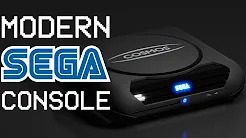

"Fantasy" computer system inspired by the SEGA DreamCast, StarDragonModels' Cosmos, the Sanyo 3DO TRY, the OUYA, the Famicube and the Nintendo 64DD.
Specifications
48-bit RISC-V-like Juniper6 SDPm (symbolic data processor module) x2-x6
Using 12-bit words as most fundamental computer unit (the smallest four binary digits )
Twelve generic 12-bit registers ( A,B,C,D,E,F,U,V,W,X,Y,Z; )
Four special-use registers (48-bit program counter, 24-bit storage accumulator, links 4-bit register & 20-bit scientific notation coefficient )
Includes a deque data structure component that can store up to ~64 12-bit elements
A RISC-like ISA { Load value to register, Load from register to register, Load from memory to register, Store register value in memory, Compare register to register, Compare register with value, Branch if equal, Branch if less, Branch if more, Branch unconditionally, Add value to register, Add register to register, Subtract value from register, Substract register from register, Bitwise Shift right, Bitwise Shift left, Bitwise Rotate left, Bitwise Rotate right, deque INJECT, deque PUSH, deque POP, deque EJECT, deque PEEK, deque DROP, deque DUPLICATE, deque SWAP, deque OVER, deque ROTATE CLOCKWISE, deque ROTATE COUNTERCLOCKWISE, deque ROLL, deque BACKPEEK, deque REVERSE ROLL, deque REVERSE DUPLICATE, deque BACKSWAP, deque UNDER, deque BACK ROTATE CLOCKWISE, deque BACK ROTATE COUNTERCLOCKWISE, deque REVERSE DROP, deque PAD, deque REVERSE PAD;), NOT, NOR, NAND, AND, OR, XOR, Carry, ?, ?, ?, ?, ?, ?, Halt, Noop; }
64-bit wide instructions { 8-bit opcode, (6-8 extension?) 4-bit register, 48-bit data }
Expanded UTF-8 encoding
480x288p RGBA 12-bit/channel screen resolution at 60 FPS
144MW Unified Memory
48MW Video RAM for 48-bit programmable opacity display
48MW Audio RAM for 8D audio
4MW SRAM for libre bootloader & machine-level utilities
48GW Storage (using the last 16GW as swap)
DirectMemoryAccess feature
32-bit stereo sound
SAM= Symbolic Analog Monitor, secular overseer system daemon that handles much software time-sharing functions in a transparent and empowering manner
MAM= Magickal Agent Mentor, group of utilities for spiritual esoteric and user guidance
WAX= Wirebox Analog eXecutive, low-power analog processor for timeless processing
ZeraDPS (ZealOS-like operating system)
VeneraDIS (Linux-like desktop environment / window manager)
Sasha (Fish-like programmable shell)
Nucleus496 (Microkernel with Linux-like reliability)
Brainstorm for Angora
Programmable Autonomous Organizations (eq. to DAOs)
Mesa (multimedia and hypermedia utilities)
Macroware Veina (rich media editor with cell editing & multi-user wiki editing support, between LibreOffice and NVIM)
4Kard (cardfile / hypercard bulletin board and session time-sharing server system)
Fidel (high-level programming language quite similar to the likes of F#)
Matra (OpenXanadu equivalent as global information system / public-access wiki)
Prospero (multi-player game series by Vixen softworks aka Valve)
Solarmonk (single-player game series by Magnata softworks aka Bethesda)
Milix 3D modelling libre software similar to Blender and AutoCAD
INMOS (Assyrian/Morocco own competitor to ITS & CLADO, from '68)
CLADO (first popular operating system in Angora, developed in '59)
ITS (competitor to CLADO, developed in '63)
Perseus (successor / half-merger between most operating systems, timestamped in 1970)
COS-5 (COS-310 DIBOL environment wth Tmux windowing, TAKO Emacs text editor & Bish shell)
SASS (early Windows equivalent from EBM and Macroware, not very popular)
Van (Win98/ME/ArcaOS-like, still not very popular)
Synod (Ring-0 Microsoft Bob equivalence with very cute graphics and successful with the youth)
Nomad (Uxn / Plan9 / Inferno)
Tiger (C-like programming language, similar to Nim, Lobster, Python and Lua)
Chateau (OpenIndiana / Haiku / PhantomOS / macOS)
Arbav subsystem { affirmation-based emulation, voice-operated system and analog GAI modular section }
Symbolic Algebra system { Fractions, soviet balanced ternary operations, simplifier, garbage collection, arbitrary precision arithmetic, mathematical algorithms & special functions, polynomials, artificial neural network emulation alternative, mathematical constants, optimizations, linear & non-linear equations, integral transformations, series operations, matrix operations, statistical computation, plotting graphs, charts/diagrams?, differential equations, signal processing, sound synthesis, SIN/COS/TAN, constraint logic programming, API library of addon functions; }
FastMath Co-Operative Processing Unit { Multiply, Division, Floating Point Arithmetics, Random Number Generator, POSIX-compliance, optimized code generation, string manipulations, base converters, bitwise logic operators?, square roots, exponents, logarithmic, trigonometrics; }
BASIC + DIBOL
PacoLisp (tiny & versatile low-level) & MiraLisp (much infrastructure & documentation)
HaxelN (virtual memory editor)
Hixi (powerful scripting spreadsheet editor, not by Macroware)
Nao (open media document specification like DolDOC)
Maskoch, disk / partition / physical media editor
Zira I/O, bus, drivers and card expansions
PETSCII-like graphical primitives set
Athena (JVM eq.)
Argdown (extended LaTex / Markdown specification)
Witness (Swift-like)
Mao (visual programming language between Fortran, Turtle graphics and AGAT Robic)
Ruin (very advanced debugger & cryptoanalysis utility suite)
Monada (a famous code poem written in the seventies, similar to a benchmarking "Hello, World!" program for synthetics)
SMall-Talk (professional programming language for databases and parallelist mainframe operations)
Adwa (Multilingual symbolic programming system layer similar to IPL)
'Maniac' operating system (MUSIC/SP eq.)
#maskutchew#16^12#servitor#angora#blackhand#world building#yep I take major hints from history and research and tweak things as I go#I really should start my YouTube channel and development projects for this jazz
18 notes
·
View notes